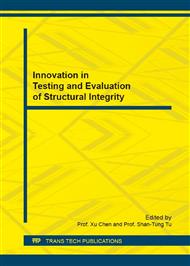[1]
J. Leicht, N.A. Castro, E.C. Silva, et al. Magnetic properties of 6. 5% silicon content non-oriented electrical steel under sine and PWM excitation, J. Journal of Magnetism and Magnetic Materials, 2008, 320(14): e385-e8.
DOI: 10.1016/j.jmmm.2008.02.156
Google Scholar
[2]
T. Yamaji, M. Abe, Y. Takada, et al. Magnetic properties and workability of 6. 5% silicon steel sheet manufactured in continuous CVD siliconizing line, J. Journal of Magnetism and Magnetic Materials, 1994, 133(1-3): 187-9.
DOI: 10.1016/0304-8853(94)90521-5
Google Scholar
[3]
H. Kato, A. Nagamune, S. Kasai, et al. Online precise measurement of Si content for content graded 6. 5% Si steel sheet, C. Proceedings of the SICE Annual Conference 2004, August 4, 2004 - August 6, 2004, Sapporo, Japan, F, (2004).
Google Scholar
[4]
S. Konoplyuk, T. Abe, T. Uchimoto, et al. Characterization of ductile cast iron by eddy current method, J. NDT and E International, 2005, 38(8): 623-6.
DOI: 10.1016/j.ndteint.2005.02.008
Google Scholar
[5]
D. Mercier, J. Lesage, X. Decoopman, et al. Eddy currents and hardness testing for evaluation of steel decarburizing, J. NDT and E International, 2006, 39(8): 652-60.
DOI: 10.1016/j.ndteint.2006.04.005
Google Scholar
[6]
A.M. Sheikh, M. Kashefi. Application of eddy current nondestructive method for determination of surface carbon content in carburized steels, J. NDT & E International, 2009, 42(7): 618-21.
DOI: 10.1016/j.ndteint.2009.04.008
Google Scholar
[7]
S.H. Khan, F. Ali, A.N. Khan, et al. Pearlite determination in plain carbon steel by eddy current method, J. Journal of Materials Processing Technology, 2008, 200(1-3): 316-8.
DOI: 10.1016/j.jmatprotec.2007.09.003
Google Scholar
[8]
L.K. Kogan, A.P. Nichipuruk, L.D. Gavilova. Effect of the carbon content on the magnetic and electric properties of thermally treated carbon steels and the possibilities of testing the quality of tempering of articles produced from them via the eddy-current method, J. Russian Journal of Nondestructive Testing, 2006, 42(9): 616-29.
DOI: 10.1134/s1061830906090063
Google Scholar
[9]
A. Lois, M. Ruch. Assessment of martensite content in austenitic stainless steel specimens by eddy current testing, J. Insight: Non-Destructive Testing and Condition Monitoring, 2006, 48(1): 26-9.
DOI: 10.1784/insi.2006.48.1.26
Google Scholar
[10]
T. Uchimoto, T. Takagi, S. Konoplyuk, et al. Eddy current evaluation of cast irons for material characterization, C. Proceedings of the Second Moscow International Symposium on Magnetism (MISM), June 20, 2001 - June 24, 2001, Moscow, Russia, F, (2003).
DOI: 10.1016/s0304-8853(02)01068-5
Google Scholar
[11]
A. Lois, H. Mendonca, M. Ruch. Conductivity calculations from eddy current measurements on thin specimens, J. Insight: Non-Destructive Testing and Condition Monitoring, 2002, 44(5): 279-84.
DOI: 10.1784/insi.2006.48.1.26
Google Scholar


